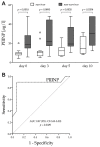Procollagen I and III as Prognostic Markers in Patients Treated with Extracorporeal Membrane Oxygenation: A Prospective Observational Study
- PMID: 34441982
- PMCID: PMC8397027
- DOI: 10.3390/jcm10163686
Procollagen I and III as Prognostic Markers in Patients Treated with Extracorporeal Membrane Oxygenation: A Prospective Observational Study
Abstract
Background: Procollagen peptides have been associated with lung fibroproliferation and poor outcomes in patients with acute respiratory distress syndrome (ARDS). Therefore, serum procollagen concentrations might have prognostic value in ARDS patients treated with extracorporeal membrane oxygenation (ECMO). Methods: In a prospective cohort study, serum N-terminal procollagen I-peptide (PINP) and N-terminal procollagen III-peptide (PIIINP) concentrations in twenty-three consecutive patients with severe ARDS treated with ECMO were measured at the time of ECMO initiation and during the course of treatment. The predictive value of PINP and PIIINP at the time of ECMO initiation was tested with a univariable logistic regression and a receiver operating characteristic (ROC) curve analysis. Results: Thirteen patients survived to intensive care unit (ICU) discharge. Non-survivors had higher serum PINP and PIIINP concentrations at all points in time during the course of treatment. Serum PIIINP at the day of ECMO initiation showed an odds ratio of 1.37 (95% CI 1.10-1.89, p = 0.017) with an area under the receiver operating characteristic (ROC) curve (AUC) of 0.87 (95% CI 0.69-1.00, p = 0.0029) for death during the course of treatment. Conclusions: PINP and PIIINP concentrations differ between survivors and non-survivors in ARDS treated with ECMO. This exploratory hypothesis generating study suggests an association between PIIINP serum concentrations at ECMO initiation and an unfavorable clinical outcome.
Keywords: acute respiratory distress syndrome; extracorporeal membrane oxygenation; procollagen I; procollagen III.
Conflict of interest statement
The authors declare that they have no competing interest.
Figures


References
-
- Bellani G., Laffey J.G., Pham T., Fan E., Brochard L., Esteban A., Gattinoni L., Van Haren F., Larsson A., McAuley D.F., et al. Epidemiology, Patterns of Care, and Mortality for Patients with Acute Respiratory Distress Syndrome in Intensive Care Units in 50 Countries. JAMA. 2016;315:788–800. doi: 10.1001/jama.2016.0291. - DOI - PubMed
-
- Phua J., Badia J.R., Adhikari N.K., Friedrich J.O., Fowler R.A., Singh J.M., Scales D.C., Stather D.R., Li A., Jones A., et al. Has mortality from acute respiratory distress syndrome decreased over time? A systematic review. Am. J. Respir. Crit. Care Med. 2009;179:220–227. doi: 10.1164/rccm.200805-722OC. - DOI - PubMed
LinkOut - more resources
Full Text Sources

